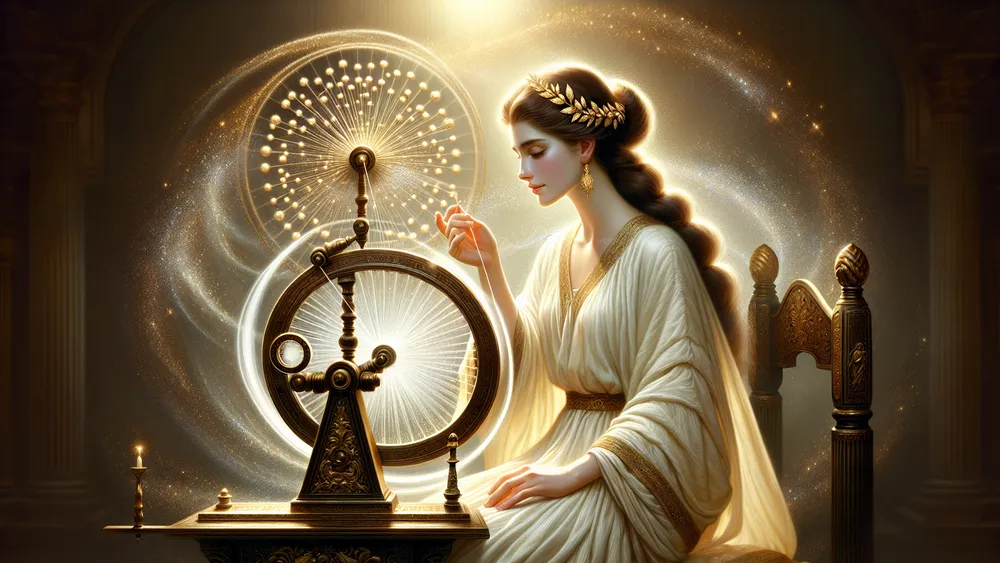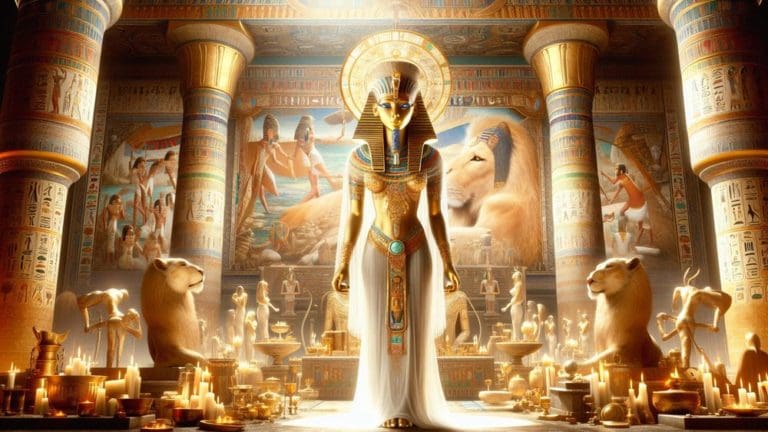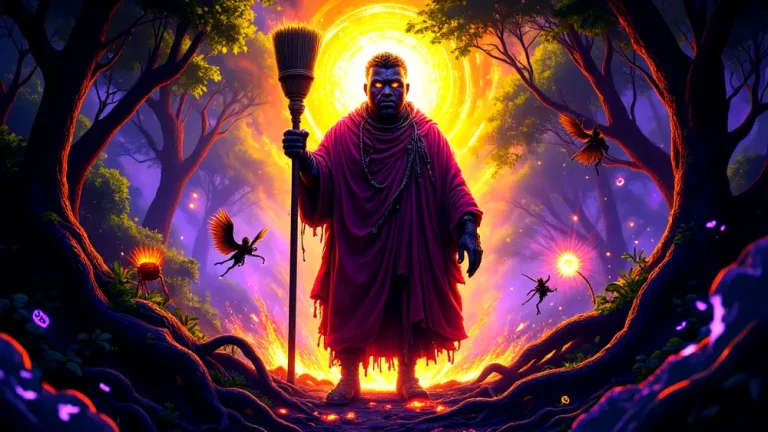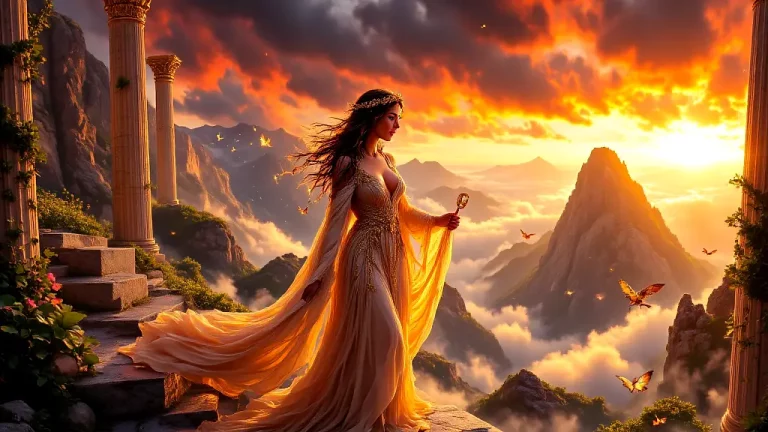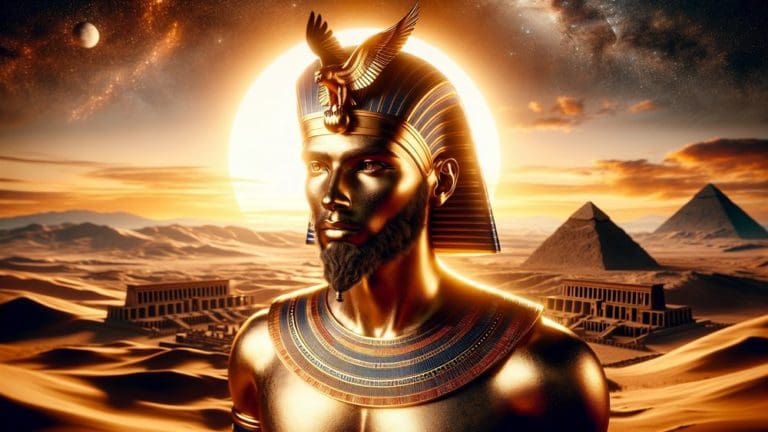Clotho: The Spinner Of Life’s Thread In Greek Mythology
In Greek mythology, the Moirai are known for a unique role: controlling what happens to both gods and mortals from start to finish. One of the three, Clotho, is the one connected with beginnings of life. She holds a spindle and spins the thread, and this thread becomes everything that makes up someone’s life. But just who is Clotho? What makes her work so important in this group of gods?
Key Points:
- Clotho spins the thread of life, marking the start of someone’s existence.
- She uses a spindle, thread, and distaff, tools linked to beginnings and life’s fragility.
- Admetus’ myth shows her bending rules briefly but keeping balance.
- Her spinning was key in starting lives of heroes like Heracles and Achilles.
- Clotho’s work connects human lives with divine plans, balancing gods and mortals.
- Her role ties closely to her sisters: Lachesīs measures life, and Atropos cuts it.
- Even Zeus must respect her decisions, showing her power in the cosmic order.
To understand her better, it’s important to know how the Moirai fit together – this group is often just called the Fates. These three, as a team, handle life like it is a carefully planned creation. It’s Lachesīs who measures the thread, and Atropos, the one who cuts it off when it ends.
This blog focuses on unraveling what Clotho did, why she mattered, and how her tools connected her to creative power. From the lives of mortal heroes to decisions made by the gods, Clotho’s creative contributions are hard to miss, just like the work of a spinner shaping what happens next. As we go deeper into this, keep in mind that Greek mythology isn’t just one story.
Instead, it’s a mix of ideas about history, beliefs, and art. These stories come together to become something complete. For those new to ancient myths or returning to them, Clotho’s role can help you better understand life, creation, and how fragile everything really is.
Clotho: Overview and Key Facts
| Key Aspect | Details |
|---|---|
| Name | Clotho (Greek: Κλωθώ), from a Greek word that means “to spin.” |
| Role | One of the Moirai (Fates) in myths where she spins the thread that begins life. |
| Symbolism | Is about birth, making things, and how life carefully starts. |
| Siblings | Her sisters are Lachesīs, who measures the thread, and Atropos, the one who cuts it. |
| Tools | She works with a spindle, which she uses for spinning. The thread symbolizes life. |
| Domain | Clotho decides the starting point of mortal life and indirectly when gods begin too. |
| Mythological Role | She and her sisters handle life’s journey, making sure everything happens as it should. |
| Authority | She has nearly all the power to determine what happens to gods and humans at the start. |
| Philosophical Meaning | She stands for the beginning of life, which is fragile but also important. |
| Cultural Depictions | Often appears in art with her spindle and thread, pointing to her role in creation. |
| Famous Myths | In stories, she helps with starting the lives of heroes like Heracles or Admetus. |
| Representation in Art | Typically shown as young, holding a spindle since it connects her to life’s start. |
The Moirai: The Trio Controlling Life and Death
In Greek mythology, the Moirai – sometimes called the Fates – are at the center of how life and death are understood. While many stories focus on the gods, these three figures play a critical role. They are responsible for managing the cycle of life, ensuring that everything happens as it should. We will now look closely at both their shared tasks and the parts of their work that are different.
Who Are the Moirai in Greek Mythology?
The Moirai, also called the Fates, are three goddesses in Greek mythology who are responsible for managing the lives of everyone, whether mortal or god. These three sisters each have their own specific job, and they work together to handle what happens at the very beginning of life, during life, and at its final end. Each of the Moirai plays a different role.
Clotho is the youngest of the three, and she is the one who spins the thread. This thread becomes the start of a person’s life. The next sister is Lachesīs, and her job is to measure the length of the thread. This measurement decides how long someone’s life will be and what happens to them.
The third sister, Atropos, is the oldest. She is the one who cuts the thread, which puts an end to that life forever. Together, these three goddesses take care of the entire process, from the beginning of life to the very end.
The Moirai are often thought of as forces that keep everything going in its proper order. They are seen as strict and fair, making sure that no one – not even the gods – can avoid what is supposed to happen to them. Each sister is important to this balance:
- Clotho: Starts life by spinning a thread, which represents the beginning of a person’s journey.
- Lachesīs: Measures the thread, deciding how long it lasts and what will happen during that time.
- Atropos: Ends the thread by cutting it, meaning that the person’s life is over.
By working together, the Moirai manage the natural cycle of life and death, helping things flow from the first moment to the very last.
The Moirai are three goddesses who control everything about life and death, from its start to its end, by spinning, measuring, and cutting the thread of each person’s existence.
How the Moirai Fit Into the Bigger Picture
The Moirai are not just focused on individual lives. They are closely connected to much larger and older powers in the way the world was created and still works. One of these powers is Ananke, who stands for the unavoidable rules of life that absolutely nothing and no one can go against. Even the gods must follow them.
In her system, the Moirai do their part by making sure that all threads of life and death happen in the right way to keep things balanced. Behind these forces is Chaos, which many think of as disorder, though it isn’t. Instead, Chaos is an empty space that existed before everything else and was needed for balance to appear.
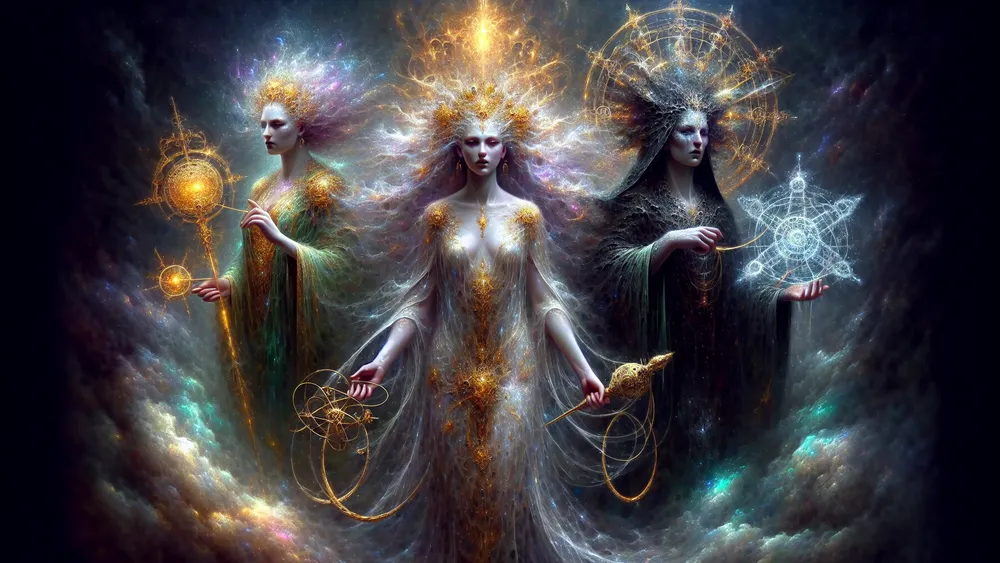
The Moirai help keep this balance steady by controlling life and death carefully so that neither one overpowers the other. Their power is hard to understand because it affects both mortals and gods. Even Zeus, who is the king of all gods, cannot ignore their decisions or go against them, no matter how powerful he is.
Because they ensure that every part of life happens at the right time, the Moirai represent the way life and death work in a logical, almost mechanical, order. This idea connects them to other forces in mythology, such as Chronos, who controls time, and Dike, who is in charge of justice. Chronos keeps time moving forward endlessly, while Dike makes sure fairness is applied.
At the same time, the Moirai focus on each person’s life from beginning to end. Although they seem like goddesses in stories, the Moirai are more than mythological figures. Together, they are symbols of how the entire universe stays carefully connected and balanced, showing that every life is a part of something much greater.
What Clotho Does as Part of the Fates
Clotho, as the one who spins the thread of life, has a basic but important job in the group of three known as the Moirai. Her role marks the very beginning of life, and it is where everything else starts. Because she is responsible for this first step, Clotho’s tasks matter not just by themselves but also for how they connect to the work of the other two sisters.
We will see what her role involves and how her actions affect the entire cycle of life and death.
Spinning Life’s Thread: Clotho’s Role
In Greek mythology, Clotho is the first of the three Moirai, and her job is to spin the thread of life. This spinning marks the start of a human’s life, and it stands for the moment their fate begins. Using her spindle, Clotho decides when life starts, creating a thread that carries the unique qualities of every person.
Without Clotho’s work, no life begins. She is the one who starts everything. Clotho spins the thread which Lachesīs, the measurer, uses to figure out the length and details of each person’s life. At the same time, Atropos, the cutter, uses it to decide when that life will come to an end.
This way of working together makes sure that the starting point Clotho provides is part of the larger balance of life and death. Her work isn’t random. Instead, it is one part of a system that includes both humans and gods. You can notice Clotho’s influence in many myths about important humans and gods.
For example, Heracles, one of the greatest heroes in Greek mythology, began his life thanks to her spinning. His thread wasn’t just for his time as a mortal, but it also became part of Zeus’s larger plans. Another story involves the human king Admetus.
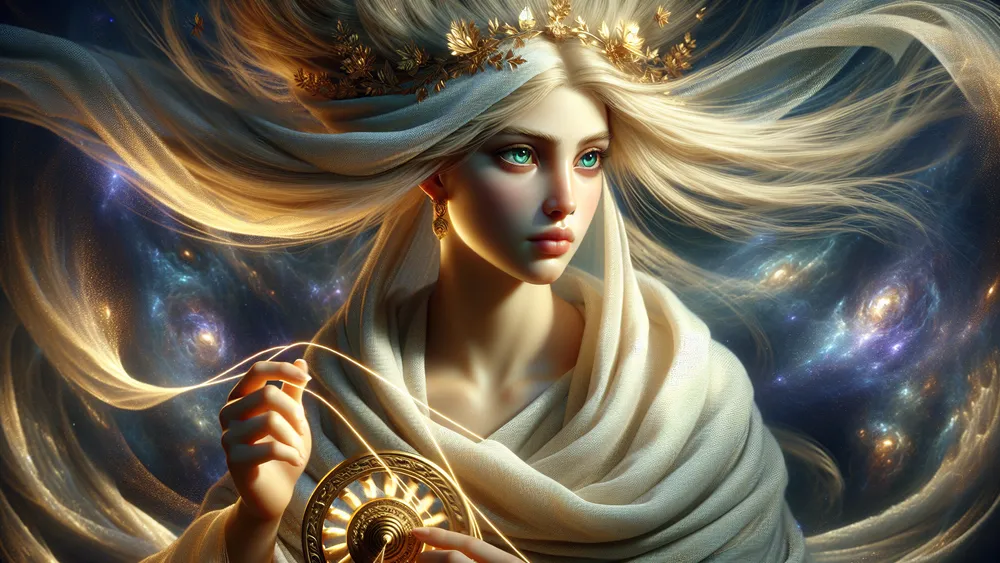
His life thread was made longer after the god Apollo asked Clotho to adjust her work for someone he cared about. These examples mean Clotho’s work is critical for both famous heroes and ordinary humans. No matter who it is, from the simplest person to someone controlled by the gods’ plans, every life begins because of Clotho’s spinning.
Where Clotho’s Name Comes From
The name Clotho comes from the Greek word klōthō (κλώθω), which means “to spin.” This word ties directly to her main job in mythology – spinning the thread of life. In ancient Greece, spinning had a deep purpose. People saw it as connected to beginnings and the way different parts of life came together into one piece.
Because of this, Clotho’s name connects her to spinning threads, which is the way she begins all human life. Everything starts with her. In her role, Clotho spins the very first thread of fate, making it clear that her job is the one that starts life. Without her, nothing would begin.
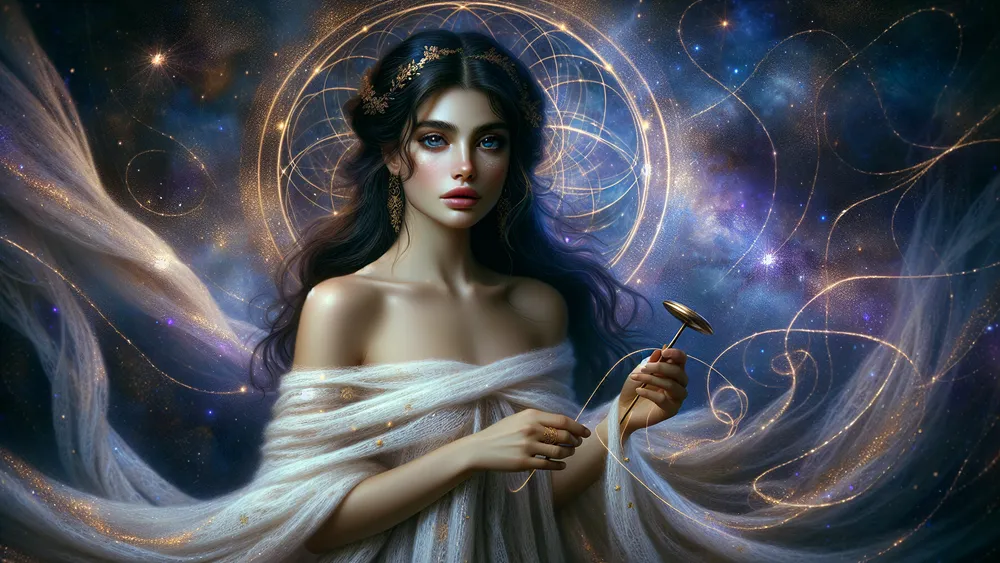
Spinning also connected her name to the larger system of the cosmos, where she did her work in line with the balance of fate that gods and mortals followed. Because her name is tied so closely to her actions, her purpose is simple but critical.
Although spinning threads is an ancient act, you might imagine it like how a spinning wheel today turns fibers into fabric. Her name mixes the idea of starting something new with the idea of keeping everything connected. In all of this, Clotho’s name doesn’t just explain her role.
It also means something bigger: it connects life and creation to the broader system of fate.
Myths Where Clotho Steps Into the Spotlight
One of the most interesting stories about Clotho features Admetus and Apollo. In this myth, the god Apollo was punished by Zeus and had to live as a servant among humans. He spent a year with King Admetus, who treated him with kindness. Because of this, Apollo wanted to reward the king by letting him live longer.
But Admetus’ thread of life had already been spun, and changing it wasn’t allowed by the rules Clotho and the other Moirai followed. For one of the only times ever, Apollo convinced Clotho to make an exception. She agreed, on one condition: someone else had to die in his place.
Clotho did what Apollo asked, but only in a way that still kept balance, which showed her fair and equal nature. Clotho’s work is also important in the stories of heroes like Heracles. She spun his thread of life, not just for his birth but also to set him on a path made to fit Zeus’s larger plans. Heracles wasn’t just born to live a normal life.
His thread was made so he could complete great tasks, called labors, that would keep the universe balanced. He later became a god. By spinning Heracles’ thread, Clotho made sure both his struggles as a mortal and his future as a god would happen. This is the same for other famous figures, such as Achilles and Odysseus.
They were given special threads filled with unique fates, but Clotho stayed fair. She started their lives but didn’t interfere with what happened to them later. You can also see Clotho’s influence in the story of the Trojan War. While she wasn’t involved in arguments between gods and mortals, her spinning started events that led to the war.
For example, her work made Helen of Troy the most beautiful human. This started the events that caused the war. She also spun the threads of Paris, Achilles, and Hector, making sure their fates would connect. In this way, Clotho’s role means that every action is tied to the paths she spun into life’s structure. She doesn’t take sides. She doesn’t favor gods, humans, or heroes.
Instead, her work represents life’s paths being made without bias.
- Key Themes in Clotho’s Myths:
- Admetus and Apollo: Clotho bent her rules briefly, but still kept fate balanced by requiring a fair exchange.
- Creation of Heroes: Her threads gave mortals like Heracles paths that matched plans made by gods.
- Trojan War: Her spinning connected different lives, leading to important moments marked by both human and divine involvement.
What Clotho’s Tools Say About Her Job
Clotho uses her tools – spindle, thread, and distaff – to do her main job, which is spinning the start of life. The spindle is probably her most well-known item because it’s used to create threads, helping life begin. Like how people use a spindle to twist raw material into something you can use, Clotho spins her threads to turn possibilities into reality.
This spindle represents life starting, but not just for one person. It also connects all lives together as part of a bigger system. At the same time, the thread Clotho spins stands for life itself. It’s fragile and doesn’t last, showing how short life can be. The thread also connects many lives into a bigger whole, where human and godly lives meet.
Its delicate nature reminds people of life’s fragile balance and its simple place inside the endless cosmos. The distaff is another item Clotho works with, though it’s not as famous. It holds raw fibers for spinning, which Clotho then uses to make thread. The distaff represents the start of everything – where life begins as something not yet formed.
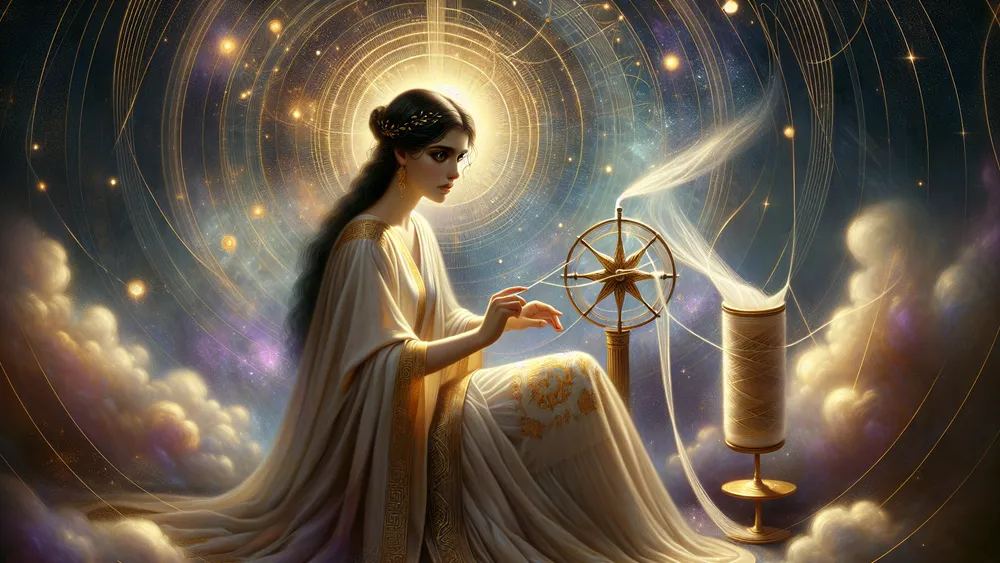
For Clotho, it works as a connection between big, powerful forces and the actual start of life. It shows that while humans may think they control life, their destinies often come from larger plans they don’t see. In ancient art, Clotho sometimes holds one of these tools, which draws attention to how all three are part of her important role.
The spindle, thread, and distaff do more than create life. They point to life’s connections, its creative start, and how it follows a pattern that nothing can change.
| Tool | Function | Symbolism |
|---|---|---|
| Spindle | Spins material into thread | Stands for starting life and connecting it into a larger system. |
| Thread | Made by spinning | Represents how short life is and its ties to the rest of existence. |
| Distaff | Holds raw fibers for spinning | Shows how bigger forces guide life’s start and connect humans to greater plans. |
Clotho uses her spindle, thread, and distaff to start life, symbolizing life’s fragility, connections, and how larger forces shape its path.
How Clotho Connects With Gods and Mortals
By combining the threads of mortal lives with the plans of gods, Clotho works as a key connection between humans and the universal system the gods control. Her role is important. She takes care of human lives while also making sure that divine plans continue as expected. Clotho’s work ties these two worlds together. Human fates depend on her, and so do the goals of the gods.
Without her, life would not move forward, and divine plans would not happen.
How Clotho Works With Zeus and Other Gods
Clotho has an important position in carrying out Zeus’s plans but remains independent in her work. Even though Zeus is known as the ruler of the cosmos, he is still tied to the rules that Clotho and her sisters manage. By spinning life threads, Clotho helps make sure that every person’s role in both the human and divine worlds fits within the universal balance.
This is something that even Zeus respects and uses in his own plans. For example, Zeus depends on the Fates, including Clotho, to spin the threads of mortal heroes like Heracles. These heroes play roles that match Zeus’s goals to keep order in the cosmos. But even though Zeus relies on the Fates, he cannot change what Clotho decides when she spins her threads.
This shows how Clotho’s neutral work is both a tool for Zeus and a limit to his powers. One story that makes this clear is the tale of Apollo and King Admetus. When Zeus punished Apollo and made him live as a servant to a mortal, Apollo wanted to repay Admetus for being kind to him.
To do this, Apollo tried to change Admetus’s life thread so the king could live longer, but Clotho’s usual rules didn’t allow alterations like this. In a rare event, Clotho found a way to approve Apollo’s request but under strict conditions: another person had to willingly give up their life to extend Admetus’s.
By working with Apollo, Clotho still followed the main rule of balance by requiring an equal exchange. This simple but strict decision showed how she stayed neutral, even when working with powerful gods, and how the role of the Fates fits into keeping the universal system steady.
Clotho’s Impact on Mortals and Heroes
Clotho’s fair spinning of life threads can be seen in the destinies of well-known mortal heroes like Achilles. In Greek mythology, Clotho spun Achilles’ thread so that his life would include both amazing glory and unavoidable tragedy. His thread tied him to the Trojan War, where he became one of its most important figures.
As the strongest warrior, he gained fame, but his fate was already set – he would die young. This balance between power and an early death represents how Clotho stays neutral while deciding how a life begins.
When Achilles met his end because of a wound in his heel, it was clear that Clotho’s work only determined his beginning, leaving other forces – like choices and actions by humans or gods – to decide what happened next.
You could think of it this way: Clotho creates a fixed plan for when someone’s life starts, but what happens after that depends more on emotions, divine actions, or personal decisions. Another example of Clotho’s work is seen in the life of Odysseus, the clever king of Ithaca. When Clotho spun Odysseus’ thread, she gave him traits like intelligence and determination.
These traits helped him get through things like the Trojan War and his long, difficult journey back home in the Odyssey. Even though she gave him these abilities, Clotho never stepped in to protect him from struggles, like Poseidon’s anger or the losses he suffered along the way.
While Odysseus was shaped by the qualities that Clotho wove into his thread, his challenges were left to other forces. By creating specific traits and destinies, Clotho starts each life in a way that fits into the bigger system joining mortal lives with the plans of gods.
Each thread she spins connects smoothly with others in the grand system of humanity and the divine order. Similar to how someone finishes one piece of work without changing earlier parts, Clotho spins new lives without going back to modify what has already been woven.
The Three Fates: Comparing Clotho, Lachesīs, and Atropos
Clotho, Lachesīs, and Atropos are three figures who stick together and cannot be separated. Each of them does a critical job in the way life begins, continues, and ends. Because they must work together, they create a system that keeps everything running smoothly. If you want to completely understand Clotho’s place, it is helpful to compare what she does with the tasks her sisters manage.
While Clotho begins the lives of mortals, each sister plays her own role. Together, the three of them make up the important parts of the life cycle that affects all humans and even gods.
All the Greek Abstract and Natural Forces
Greek mythology is strongly based on the idea that the universe is controlled by both abstract ideas and natural powers, which are often imagined as important beings. Included in this are Ananke (Necessity), Chronos (Time), and Nyx (Night), along with many others that affect how everything in the universe works.
If you want to find a complete collection of all the Greek Abstract and Natural Forces, you can learn how these beings control not just mortal life, but also the fates of the gods themselves. This comparison explains the way Greek mythology fits its many parts into one larger system about how the universe runs.
To learn more, you can explore a detailed list of all the Greek Abstract and Natural Forces.
FAQs
1. What is Clotho’s primary role?
Clotho’s primary role is to spin the thread of life, initiating the existence of every mortal.
2. What myths prominently feature Clotho?
Myths prominently featuring Clotho include her pivotal role in deciding the life thread of Admetus and intertwining heroic destinies like those of Heracles.
3. How was Clotho depicted in ancient Greek art?
Clotho was depicted in ancient Greek art as a serene figure holding a spindle, symbolizing her role as the spinner of life’s thread.
4. Do mortals ever escape Clotho’s weaving?
Mortals rarely escape Clotho’s weaving, as their fates are bound to the threads she spins, with any attempts often resulting in tragic consequences or divine intervention.

